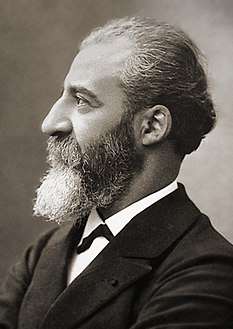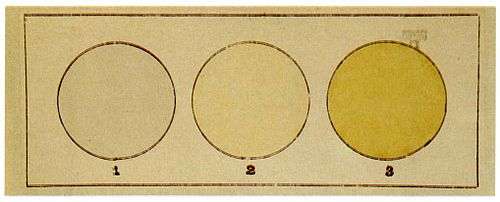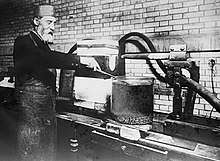Henri Moissan
Ferdinand Frédéric Henri Moissan (28 September 1852 – 20 February 1907) was a French chemist and pharmacist who won the 1906 Nobel Prize in Chemistry for his work in isolating fluorine from its compounds. Moissan was one of the original members of the International Atomic Weights Committee.[1][2]
Henri Moissan | |
|---|---|
 | |
| Born | Ferdinand Frédéric Henri Moissan 28 September 1852 Paris, France |
| Died | 20 February 1907 (aged 54) Paris, France |
| Nationality | France |
| Alma mater | Collège de Meaux École Pratique des Haute Études |
| Known for | Isolation of fluorine |
| Spouse(s) | Marie Léonie Lugan Moissan (m. 1882; 1 child) |
| Awards | Davy Medal (1896) Elliott Cresson Medal (1898) Nobel Prize for Chemistry (1906) |
| Scientific career | |
| Fields | Chemistry |
| Institutions | Sorbonne |
| Doctoral advisor | Pierre Paul Dehérain |
| Doctoral students | Paul Lebeau Maurice Meslans |
| Signature | |
Biography
Moissan was born in Paris on 28 September 1852, the son of a minor officer of the eastern railway company, Francis Ferdinand Moissan, and a seamstress, Joséphine Améraldine (née Mitel).[3] His mother was of Jewish descent,[4][5] his father wasn't.[4][5] In 1864 they moved to Meaux, where he attended the local school. In 1870 he left the school without the grade universitaire necessary to attend university. Moissan became a trainee in pharmacy in 1871 and in 1872 he started working for a chemist in Paris, where he was able to save a person poisoned with arsenic. He decided to study chemistry and began first at the laboratory of Edmond Frémy and later at that of Pierre Paul Dehérain. Dehérain persuaded him to pursue an academic career. He passed the baccalauréat, which was necessary to study at university, in 1874 after an earlier failed attempt. He also became qualified as first-class pharmacist at the École Supérieure de Pharmacie in 1879, and received his doctoral degree from the Faculté des Sciences in 1880. During his time in Paris he became a friend of the chemist Alexandre Léon Étard and the botanist Vasque.[6]
He published his first scientific paper, about carbon dioxide and oxygen metabolism in plants, with Dehérain in 1874. He left plant physiology and then turned towards inorganic chemistry; subsequently his research on pyrophoric iron was well received by the two most prominent French inorganic chemists of that time, Henri Etienne Sainte-Claire Deville and Jules Henri Debray. After Moissan received his Ph.D. on cyanogen and its reactions to form cyanures in 1880, his friend Landrine offered him a position at an analytic laboratory. His marriage, to Léonie Lugan, took place in 1882. They had a son in 1885.
During the 1880s, Moissan focused on fluorine chemistry and especially the production of fluorine itself. He had no laboratory of his own, but used several laboratories, for example that of Charles Friedel. There he had access to a strong battery consisting of 90 Bunsen cells which made it possible to observe a gas produced by the electrolysis of molten arsenic trichloride; the gas was reabsorbed by the arsenic trichloride. The electrolysis of hydrogen fluoride yielded fluorine on 26 June 1886. The French academy of science sent three representatives, Marcellin Berthelot, Henri Debray, and Edmond Frémy, to verify the results, but Moissan was unable to reproduce them, owing to the absence from the hydrogen fluoride of traces of potassium fluoride present in the previous experiments. After resolving the problem and demonstrating the production of fluorine several times, he was awarded a prize of 10,000 francs. In subsequent years, until 1891, he focused on the study of fluorine chemistry. He discovered numerous fluorine compounds, such as (together with Paul Lebeau) SF6 in 1901. His research in the production of boron and artificial diamonds and the development of an electrically heated oven capable of reaching 3500 °C using 2200 amperes at 80 volts followed by 1900.[7]
His newly developed arc furnace led to the production of borides and carbides of numerous elements (e.g. silicon boride), another of his research areas.[7]
Research
Preparation of elemental fluorine

The existence of the element fluorine had been well known for many years, but all attempts to isolate it had failed, and some experimenters had died in the attempt.[8][9]
Moissan eventually succeeded in preparing fluorine in 1886 by the electrolysis of a solution of potassium hydrogen difluoride (KHF2) in liquid hydrogen fluoride (HF). The mixture was needed because hydrogen fluoride is a nonconductor. The device was built with platinum/iridium electrodes in a platinum holder and the apparatus was cooled to −50 °C. The result was the complete isolation of the hydrogen produced at the negative electrode from the fluorine produced at the positive one.[10][11] This is essentially still the way fluorine is produced today. For this achievement, he was awarded the Nobel Prize in 1906. Late in his life, the government of France named him a Commandeur de la Legion d'honneur.
Further studies

Moissan went on to study fluorine chemistry in great detail, contributed to the development of the electric arc furnace and attempted to use pressure to synthesize diamonds [12] from the more common form of carbon. In 1893, Moissan began studying fragments of a meteorite found in Meteor Crater near Diablo Canyon in Arizona. In these fragments he discovered minute quantities of a new mineral and, after extensive research, Moissan concluded that this mineral was made of silicon carbide. In 1905, this mineral was named moissanite, in his honor. In 1903 Moissan was elected member of the International Atomic Weights Committee where he served until his death.[13]
Death
He died suddenly in Paris in February 1907, shortly after his return from receiving the Nobel Prize in Stockholm. His death was attributed to an acute case of appendicitis.
References
- Fechete, Ioana (2016). "Ferdinand Frédéric Henri Moissan: The first French Nobel Prize winner in chemistry or nec pluribus impar". Comptes Rendus Chimie. 19 (9): 1027–32. doi:10.1016/j.crci.2016.06.005.
- Viel, C. “Henri Moissan: the Man, the Collector, the Teacher.” Annales Pharmaceutiques Francaises, U.S. National Library of Medicine, Jan. 2008, www.ncbi.nlm.nih.gov/pubmed/18435984. "Moissan was the only French pharmacist to have received this high distinction."
- "Archived copy" (PDF). Archived from the original (PDF) on 9 November 2013. Retrieved 11 February 2013.CS1 maint: archived copy as title (link)
- Jaime Wisniak: Henri Moissan – The Discoverer of Fluorine. 2002.
- Werner, Eric; Runes, Dagobert D. (March 1951). "The Hebrew Impact on Western Civilization". Notes. 8 (2): 354. doi:10.2307/890014. ISSN 0027-4380. JSTOR 890014.
- Lafont, O. “De L'apprentissage Au Prix Nobel : Le Fabuleux Destin D'Henri Moissan.” Annales Pharmaceutiques Françaises, Elsevier Masson, 2 Apr. 2008, www.sciencedirect.com/science/article/pii/S0003450908000072
- "Henri Moissan – Facts". NobelPrize.org. Retrieved 6 May 2020.
- Toon, Richard (1 September 2011). "The discovery of fluorine". Education in Chemistry. Vol. 48 no. 5. Royal Society of Chemistry. pp. 148–151.
- Weeks, Mary Elvira (1932). "The discovery of the elements. XVII. The halogen family". Journal of Chemical Education. 9 (11): 1915–1939. Bibcode:1932JChEd...9.1915W. doi:10.1021/ed009p1915.
- H. Moissan (1886). "Action d'un courant électrique sur l'acide fluorhydrique anhydre" [The action of an electric current on anhydrous hydrofluoric acid]. Comptes rendus hebdomadaires des séances de l'Académie des sciences (in French). 102: 1543–1544.
- H. Moissan (1886). "Sur la décomposition de l'acide fluorhydrique par un courant électrique" [On the decomposition of hydrofluoric acid by an electric current]. Comptes rendus hebdomadaires des séances de l'Académie des sciences (in French). 103: 202.
- Moissan, Henri (1893). "Le diamant : conférence faite à la Société des amis de la science le 17 mai 1893" [The diamond: lecture to the Society of Friends of Science 17 May 1893] (in French). Europeana. Archived from the original on 13 February 2013. Retrieved 27 June 2012.
- "Atomic Weights and the International Committee—A Historical Review". Chemistry International. 2004.
Further reading
- Stock, Alfred (1907). "HENRI MOISSAN". Berichte der Deutschen Chemischen Gesellschaft. 40 (4): 5099–5130. doi:10.1002/cber.190704004183.
- Morachevskii, A. G. (2002). "Henri Moissan (To 150th Anniversary of His Birthday)". Journal Russian Journal of Applied Chemistry. 75 (10): 1720–1722. doi:10.1023/A:1022268927198.
- Samsonov, G. V.; Obolonchik, V. A. (1886). "Frederic Henri Moissan, on the 120th anniversary of his birth". Journal Powder Metallurgy and Metal Ceramics. 11 (9): 766–768. doi:10.1007/BF00801283.
- Tressaud, Alain (October 2006). "Henri Moissan: winner of the Nobel Prize for Chemistry 1906". Angew. Chem. Int. Ed. Engl. 45 (41): 6792–6. doi:10.1002/anie.200601600. PMID 16960820.
- Royère, C. (March 1999). "The electric furnace of Henri Moissan at one hundred years: connection with the electric furnace, the solar furnace, the plasma furnace?". Annales pharmaceutiques françaises. 57 (2): 116–30. PMID 10365467.
- Kyle, R. A.; Shampo M A (October 1979). "Henri Moissan". JAMA. 242 (16): 1748. doi:10.1001/jama.242.16.1748. PMID 384036.
- Flahaut, J. (March 1999). "The scientific contributions of Moissan". Annales pharmaceutiques françaises. 57 (2): 101–7. PMID 10365465.
- Viel, C. (March 1999). "Henri Moissn, first French Nobel prize winner in chemistry: the man, the picture collector". Annales pharmaceutiques françaises. 57 (2): 94–100. PMID 10365464.
- Wery, P. (January 1986). "Fluoride is 100 years old". Médecine et Hygiène. 45 (1685): 138. PMID 3543628.
- Kempler, K. (March 1982). "[On the 75th anniversary of the death of Henri Moissan]". Orvosi Hetilap. 123 (12): 740–1. PMID 7041048.
- FABRE, R. (May 1953). "Ceremonies commemorating the centenary of the birth of Henri Moissan". Annales pharmaceutiques françaises. 11 (5): Suppl, 65–7. PMID 13080837.
External links
| Wikimedia Commons has media related to Henri Moissan. |
| Wikisource has original works written by or about: Henri Moissan |
- Henri Moissan on Nobelprize.org
- Scientific genealogy
- Books and letters by Henri Moissan in Europeana
